Electrical wiring in the house can be carried out in a hidden and open way. In the first case, the wires are retracted into the wall in specially made grooves. If the wiring is open, the conductors must be hidden with special cable channels from mechanical damage. They also protect a person from electric shock. Channels come in different types and sizes, each type has its own positive and negative sides.
Types of cable channels
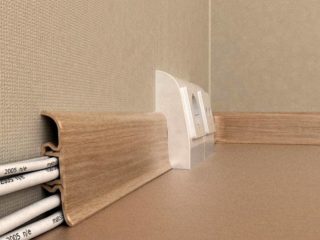
Electrical wiring in the home and in the workplace is different. Both types of premises have their own characteristics, climatic conditions, dimensions, load, and therefore the components must be different. There are the most popular cable ducts that are applicable in everyday life and in industrial environments.
Types of cable ducts for wiring:
- Made of plastic.
- From various types of metals.
- Plastic corrugated pipes.
- Metal corrugated pipes.
- Smooth rigid pipes.
Less commonly, cable channels made of other materials (for example, wood) can be used. This is due to the fact that they have worse characteristics than plastic and metal products.
Plastic cable channels
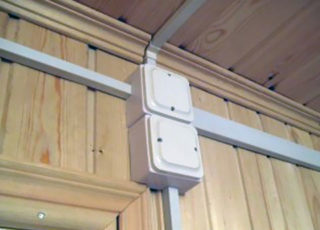
The most common area of application for plastic products is the laying of information wires in offices and the creation of temporary open electrical wiring. Plastic cable trunks vary in shapes, materials and sizes.
Initially, cable channels were produced in two colors - white and gray. In shape, they were in the form of the letter P or W. Now the assortment has expanded, on sale you can find products of different colors and shapes for laying cables for various purposes. Triangular, in the form of a hemisphere, angular boxes are widespread. They have a cover, thanks to which the cable is conveniently laid, checked and pulled out in case of need for replacement.
Non-flammable PVC or polyethylene is usually used as a material of manufacture. The standard length of one section is 2 meters. The width and height of the section are from 10 to 60 mm, but the manufacturer can make his own changes to the dimensions of the channel.
In everyday life, the most used are U-shaped cable channels. They are made with solid or perforated walls. The main advantage is low weight and low cost.
Fastening plastic cable channels to the surface
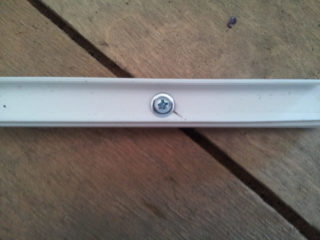
The mounting method depends on the material of the surface on which the channel is to be installed. Fastening can be done using collapsible and non-collapsible clamps. The first group includes dowel-nails, self-tapping screws, metal staples. Non-detachable fasteners are glued to cable channels.
Additional details
For ease of installation, manufacturers provide additional components. These include caps, swivel corners, tees and other mounting elements. Separate mounts for sockets and switches are also available. They are mounted in special elements that are fixed in the cable channel.
Advantages and disadvantages
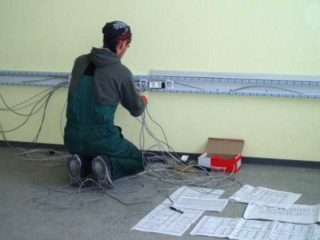
The positive aspects of plastic cable channels include:
- no need to gouge walls;
- openness of the cable for inspection;
- reliable protection of the wire from mechanical stress;
- light weight;
- low cost;
- fast installation speed;
- a wide range of shapes to fit the channels into any interior.
Main disadvantages:
- easy to hook on the cable channel;
- the need to purchase additional accessories for high-quality installation.
Cable ducts do not always fit into the interior. They visually take a few centimeters away from the wall.
Metal boxes

Such products are practically not used in everyday life. They are designed for heavy loads, which are rare enough at home. The main area of application is industrial premises with highways consisting of a large number of conductors. To protect against corrosion, the boxes are made of galvanized steel. Section - U-shaped. There are perforated, ladder and smooth trays.
Fastening is done with anchors or bolted connections. Gluing is not used due to the large weight of the product.
Advantages of metal boxes:
- the ability to withstand a lot of weight;
- ease of tracing the paths of cable laying;
- ease of installation, verification and replacement;
- fire safety.
Disadvantages:
- not suitable for home wiring;
- narrow scope;
- it is not recommended to install in rooms with a high level of humidity due to the negative effect of water on metal.
For installation, additional parts are required to create turns and transitions.
Corrugated plastic pipes

Metal and plastic products are used on flat surfaces. But there are times when the surface has frequent bends and turns. The use of a large number of components is difficult and economically unprofitable, therefore it is better to use flexible pipes that can be bent at any angle. Corrugated pipes are attached to ordinary clips.
Visually, a PVC corrugated pipe is similar to an elastic channel with a round cross section. Such products can be used for laying any cables.
The standard inner diameter of the pipe channels is 16 to 32 mm. By appointment there are light and heavy. The former are suitable for the installation of electrical circuits inside buildings. Heavy corrugations can be used in difficult conditions and even under water. Additionally, corrugated pipes can be equipped with metal probes. They allow you to push the wire into the tube itself without damaging it.

Advantages of plastic corrugated pipes:
- the ability to install on uneven surfaces;
- tightness;
- reliable protection against external negative conditions and mechanical damage;
- ease of attachment to clips;
- ease of installation and maintenance;
- fire safety;
- wide range of applications;
- the possibility of installation on the street and under water (depending on the type of corrugated pipe).
Disadvantages:
- Difficulty working at low temperatures. They lose their elasticity and break.
- Difficulty laying the wire in case of frequent bends.
If the surface has a large number of bends, it is easier to first place the cable inside, and then proceed with the installation.
Corrugated metal pipes
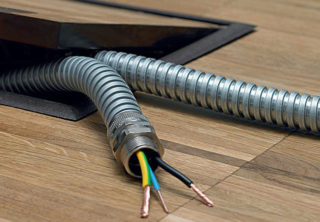
Metal analogs of plastic corrugated pipes differ in the manufacturing method. Plastic products are a completely sealed one-piece device. Metal rolls from galvanized steel tape. It is in this property that the positive and negative features of the metal corrugated pipe are determined.
Advantages of corrugated metal pipes:
- High reliability and protection of cables from mechanical damage.
- Possibility of metal hose grounding.This allows the pipe to be used as an additional electromagnetic shield. This property is especially important in the case of laying information conductors.
- Ease of installation.
Disadvantages:
- The pipe is not one-piece, which is why it is not tight. For this reason, restrictions on use are imposed.
- High cost compared to plastic products.
- Great weight.
- Immunity to negative temperatures.
At home, plastic tubes are often used to create common wiring. Metallic ones are used either for individual sections of electrical wiring, or in production.
Smooth rigid pipes for electrical wiring
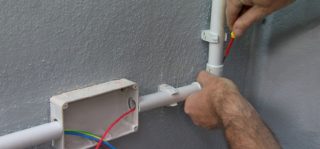
Smooth rigid pipes are used where maximum cable protection is required. They are easy to maintain, since when the wires are bricked into the wall, they give all the positive features of hidden wiring. In the event of repair or verification, you do not need to gouge the walls - you just need to pull the conductors out of the channel.
The advantages of smooth rigid pipes:
- Protection of a person from electric shock even in the event of a serious short circuit.
- High degree of fire safety.
- Low weight.
- Installation is not expensive.
Disadvantages:
- Additional fixtures and fittings are required to create turns and branches.
- Difficulty pulling wires with a large number of bends and turns.
The listed types of cable channels are the most common for installation in domestic conditions and in production. The choice of this or that channel depends on the specific case and certain conditions. You can buy a flexible cable duct for wires at any hardware or electrical store.








